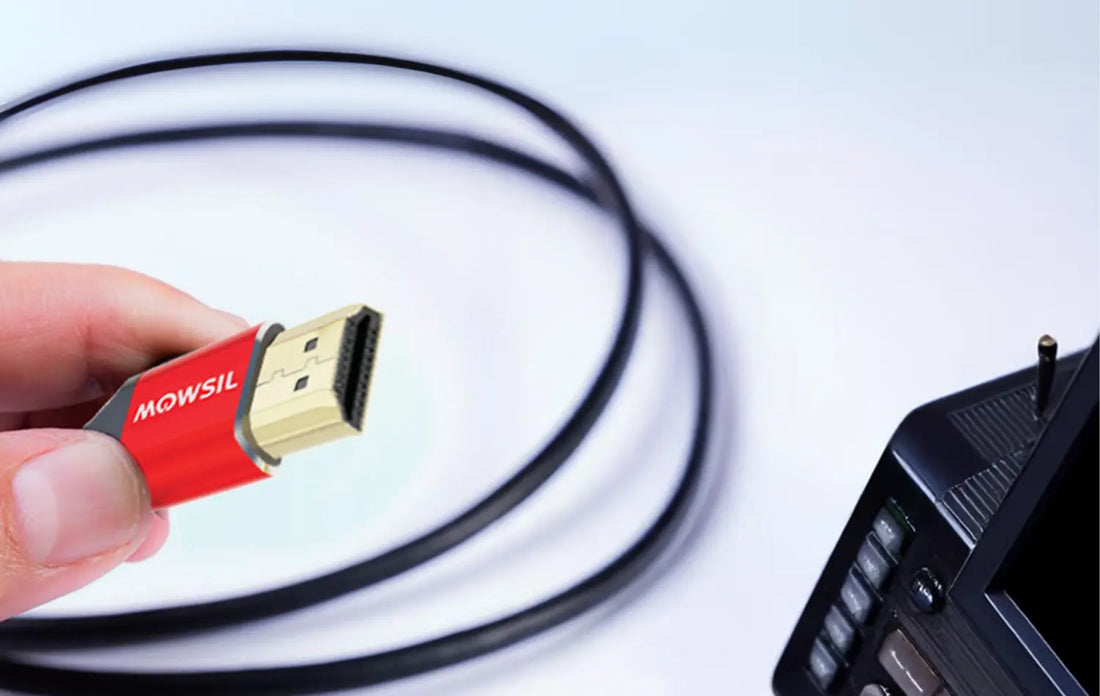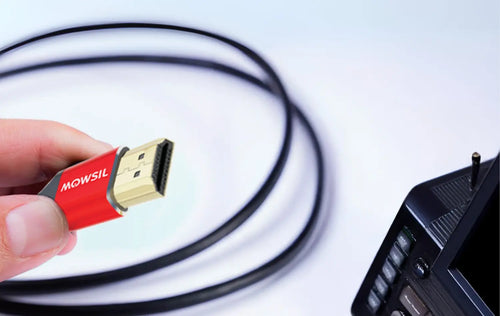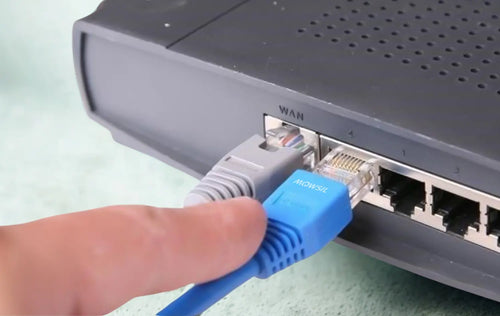استكشاف أخطاء خطأ عدم وجود إشارة HDMI وإصلاحها - حلول بسيطة وفعالة

يُعدّ منفذ HDMI من أسهل الطرق لتوصيل أجهزة مثل أجهزة التلفزيون والشاشات وأجهزة الكمبيوتر المحمولة وأجهزة العرض وأجهزة الألعاب. فهو ينقل الفيديو والصوت عبر كابل واحد، ولذلك يستخدمه معظم الناس يوميًا.
لكن في بعض الأحيان، عندما تقوم بتوصيل كابل HDMI، تظهر على شاشتك الرسالة المزعجة التالية:
"لا يوجد إشارة"
قد يكون هذا مزعجًا، خاصةً عندما تكون مستعدًا لمشاهدة فيلم أو لعب لعبة أو تقديم عرض تقديمي. لحسن الحظ، من السهل إصلاح معظم أخطاء "عدم وجود إشارة" في HDMI. ما عليك سوى معرفة من أين تبدأ.
في هذا الدليل، سنستعرض الإصلاحات البسيطة التي تعمل بالفعل.
ما الذي يسبب خطأ عدم وجود إشارة HDMI؟
قبل إصلاح المشكلة، من المفيد معرفة سبب حدوثها. الأسباب الأكثر شيوعًا هي:
-
كابل مفكوك أو تالف - قد لا يكون كابل HDMI متصلاً بشكل صحيح، أو قد يكون مكسورًا من الداخل.
-
مصدر إدخال خاطئ - قد يكون التلفزيون أو الشاشة لديك مضبوطًا على منفذ HDMI الخاطئ.
-
منفذ HDMI معيب - قد يكون المنفذ الموجود على جهازك تالفًا أو لا يعمل.
-
عدم تطابق الدقة - قد يكون جهاز الإرسال مضبوطًا على دقة لا تستطيع شاشتك التعامل معها.
-
ترتيب بدء تشغيل الجهاز – تحتاج بعض الأجهزة إلى التشغيل وفق تسلسل معين حتى يعمل HDMI.
-
مشكلة في البرنامج أو برنامج التشغيل – يمكن أن تتسبب برامج التشغيل القديمة أو خلل النظام في حدوث مشكلات في الاتصال.
إصلاحات بسيطة لمشكلة عدم وجود إشارة HDMI
دعنا نذهب خطوة بخطوة حتى تتمكن من تجربة كل حل حتى تختفي المشكلة.
1. تحقق من اتصال كابل HDMI
ربما يبدو الأمر بسيطًا للغاية، لكنه أول شيء يجب عليك فعله.
-
تأكد من توصيل طرفي كابل HDMI بإحكام.
-
حاول فصله وتوصيله مرة أخرى.
-
إذا كان الكابل يبدو مرتخيًا، فحاول استخدام كابل HDMI آخر.
في بعض الأحيان، حتى حركة صغيرة قد تؤدي إلى فشل الاتصال.
2. فحص الكابل بحثًا عن أي تلف
قد تتلف كابلات HDMI إذا تم ثنيها كثيرًا أو سحبها كثيرًا. ابحث عن:
-
جروح أو تآكلات على الغلاف الخارجي
-
دبابيس الموصل المنحنية
-
نهايات فضفاضة
إذا لاحظت أي تلف، فاستبدل الكابل. يُعدّ الكابل المعيب أحد أكثر أسباب مشاكل الإشارة شيوعًا.
3. حدد مصدر إدخال HDMI الصحيح
قد يحتوي التلفزيون أو الشاشة لديك على منافذ HDMI متعددة (HDMI 1، HDMI 2، HDMI 3، وما إلى ذلك).
-
استخدم أزرار جهاز التحكم عن بعد أو الشاشة للتبديل إلى مدخل HDMI الصحيح.
-
في بعض الأحيان، لن يعمل الجهاز الذي تحاول توصيله إلا إذا تم توصيله بمنفذ معين (خاصةً لأجهزة التلفزيون القديمة).
إذا لم تكن متأكدًا، فحاول استخدام كل مدخل HDMI حتى ترى الصورة.
4. أعد تشغيل أجهزتك
في بعض الأحيان، تؤدي إعادة التشغيل البسيطة إلى إصلاح المشكلة.
-
قم بإيقاف تشغيل كلا الجهازين (التلفزيون/الشاشة والكمبيوتر المحمول/وحدة التحكم).
-
افصلهم عن الطاقة لمدة 1-2 دقيقة.
-
قم بتوصيلهم مرة أخرى وتشغيلهم مرة أخرى.
يمكن أن يؤدي هذا إلى إعادة تعيين الاتصال وإصلاح المشكلات المؤقتة.
5. تغيير ترتيب التشغيل
يتعين تشغيل بعض الأجهزة بترتيب معين حتى تعمل ميزة مصافحة HDMI.
على سبيل المثال:
-
أولاً، قم بتشغيل التلفاز أو الشاشة.
-
ثم قم بتشغيل الجهاز (الكمبيوتر المحمول، أو وحدة التحكم، أو جهاز فك التشفير).
إذا لم ينجح ذلك، حاول عكس الترتيب.
6. جرب منفذ HDMI آخر
إذا كانت شاشتك تحتوي على أكثر من منفذ HDMI، فقم بنقل الكابل إلى منفذ مختلف.
-
إذا كان المنفذ الجديد يعمل، فقد يكون المنفذ الأصلي تالفًا.
-
إذا لم يعمل أي من المنافذ، فحاول استخدام كابل أو جهاز آخر للتأكيد.
7. الاختبار باستخدام جهاز مختلف
للتحقق مما إذا كانت المشكلة في الكابل أو الشاشة أو جهاز الإرسال:
-
قم بتوصيل جهاز آخر (مثل كمبيوتر محمول أو وحدة تحكم مختلفة) بنفس منفذ HDMI.
-
إذا نجح الأمر، فالمشكلة تكمن في جهازك الأصلي.
-
إذا لم ينجح الأمر، فالمشكلة تكمن في الشاشة أو الكابل.
8. تحقق من إعدادات دقة العرض
إذا تم ضبط جهاز الإرسال على دقة لا يدعمها شاشتك، فقد ترى رسالة "لا توجد إشارة".
-
على جهاز الكمبيوتر أو وحدة التحكم الخاصة بك، انتقل إلى إعدادات العرض وحدد دقة أقل.
-
الخيارات الآمنة الشائعة هي 1080 بكسل (Full HD) أو 720 بكسل (HD).
9. تحديث برامج التشغيل أو البرامج الثابتة
بالنسبة لأجهزة الكمبيوتر المحمولة أو أجهزة الكمبيوتر الشخصية أو أجهزة البث، قد تتسبب برامج تشغيل العرض القديمة في حدوث مشكلات في HDMI.
-
في نظام التشغيل Windows، قم بتحديث برنامج تشغيل الرسومات الخاص بك من "إدارة الأجهزة" .
-
على نظام macOS، تأكد من تحديث النظام لديك.
-
بالنسبة لأجهزة التلفزيون الذكية أو وحدات التحكم، تحقق من تحديثات البرامج الثابتة في الإعدادات.
10. تحقق من توافق HDCP
تتطلب بعض الأجهزة تقنية HDCP (حماية المحتوى الرقمي عالي النطاق الترددي) . إذا لم يدعمها جهاز التلفزيون أو كابل HDMI لديك، فقد لا تتلقى إشارة عند تشغيل محتوى محمي معين.
يمكن حل هذه المشكلة في كثير من الأحيان باستخدام كابل HDMI أحدث وعالي الجودة.
متى يجب استبدال كابل HDMI الخاص بك
إذا جربت جميع الخطوات المذكورة أعلاه وما زلت ترى رسالة "لا توجد إشارة"، فمن الأفضل استبدال كابل HDMI. مع مرور الوقت، قد يتدهور أداء الكابلات، حتى لو كانت تبدو جيدة من الخارج.
عند شراء كابل جديد، ابحث عن:
-
منفذ HDMI عالي السرعة لمحتوى بدقة 1080 بكسل و4K
-
جودة بناء جيدة مع موصلات قوية
-
الطول المناسب لإعداداتك (تجنب الكابلات الطويلة للغاية إذا لم تكن هناك حاجة إليها)
كيفية تجنب مشاكل عدم وجود إشارة HDMI في المستقبل
يمكن أن يؤدي القليل من العناية إلى منع معظم مشكلات HDMI:
-
تجنب ثني الكابل أو لفه بشكل حاد.
-
افصل الكابلات عن طريق الإمساك بالموصل، وليس بالكابل نفسه.
-
استخدم كابلات HDMI عالية الجودة، خاصةً لإعدادات 4K أو الألعاب.
-
حافظ على منافذ HDMI خالية من الغبار.
الأفكار النهائية
قد يكون خطأ "لا توجد إشارة" في HDMI مزعجًا، ولكن في أغلب الأحيان، يكون السبب بسيطًا، مثل سلك مفكوك، أو مدخل خاطئ، أو إعدادات خاطئة للجهاز. بفحص الكابل والمنافذ والإعدادات خطوة بخطوة، يمكنك إصلاح المشكلة بسرعة دون الحاجة إلى مساعدة متخصصة.
إذا كنت بحاجة إلى كابل جديد، فاختر كابلًا موثوقًا به ومصممًا ليدوم طويلاً.
في Mowsil ، نقدم مجموعة واسعة من كابلات ومحولات وموصلات HDMI عالية الجودة التي توفر فيديو وصوتًا نقيين دون انقطاع أو انقطاع. سواء كنت تُجهّز مسرحًا منزليًا أو منصة ألعاب أو شاشة مكتب، فإن منتجاتنا مصممة للأداء والمتانة. إذا كانت تقنية HDMI تُسبب لك أي مشكلة، فإن الكابل المناسب من Mowsil يُحدث فرقًا كبيرًا.



